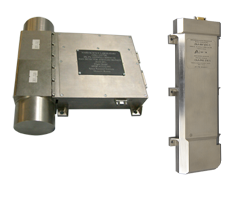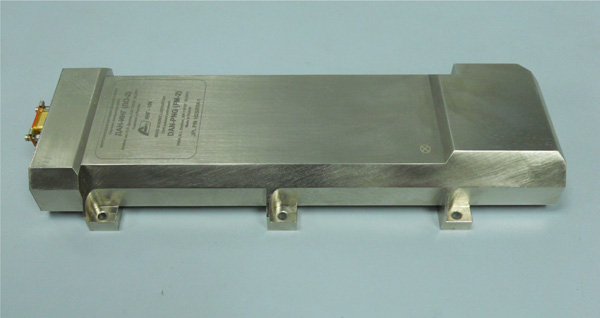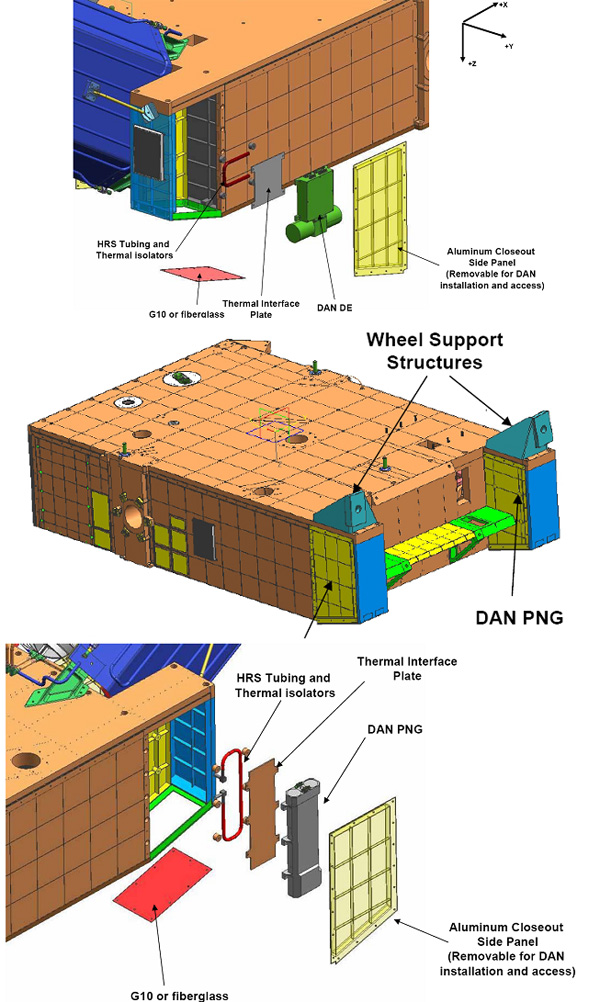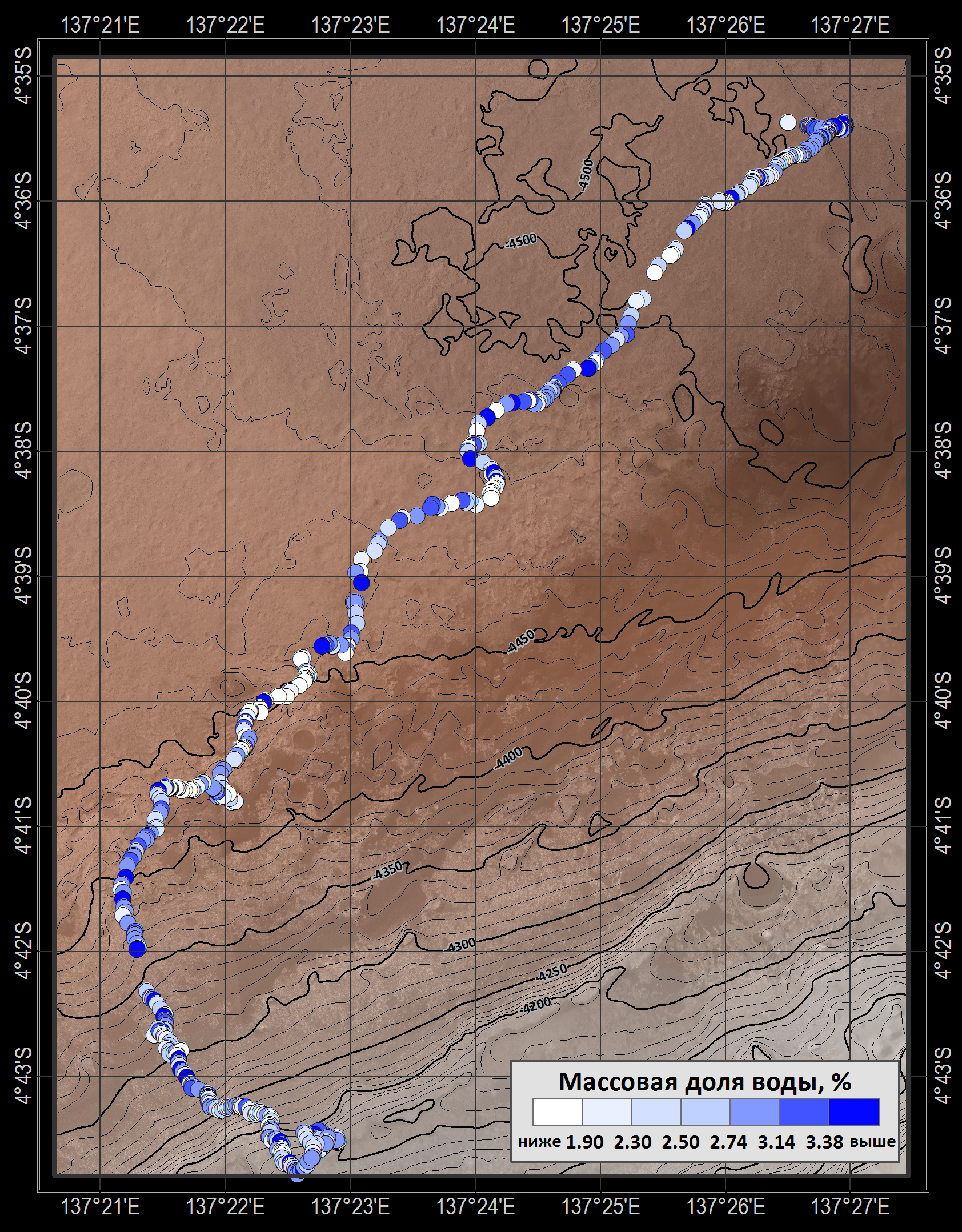Russian neutron detector DAN for NASA's Mars Science Laboratory landing rover
-------------------------------------------------------------------------------------------------------------------------------------------------
-------------------------------------------------------------------------------------------------------------------------------------------------

Scientific instruments of the Dynamic Albedo of Neutrons (DAN) experiment shall be set aboard the NASA’s Mars Scientific Laboratory 2011 (MSL-2011) interplanetary mission. The MSL-2011 program includes launch of the spacecraft MSL-2011 scheduled for 25 November 2011, cruise to Mars (approximately 1 year), landing onto the Mars surface of a module including a rover, and prolonged (about two years) observations of the Martian environment with scientific instruments aboard the rover (see NASA's press release №04-398 as of December 14, 2004, http://www.nasa.gov/).
The main objective of the DAN project is to establish a reliable and effective space instrument to study three-dimensional distribution of the bound water and water ice in shallow layer of Martian subsurface (up to 0.5–1 m with the surface resolution 1 m).
To determine the water abundance in Martian subsurface we propose to use both methods of neutron-neutron activation and neutron spectroscopy.
The physical principle of these measurements is as follows. The pulsing source of fast neutrons and detector of thermal and epithermal neutron emission are placed at a small distance above the surface (< 1m). The pulsing source generates short (pulse width ~1mks), but powerful (up to 107 neutrons per pulse) neutron pulses (with the energy of 14 MeV). The emitted neutrons penetrate into Martian soil to interact with the nuclei of main rockforming elements through reactions of inelastic scattering and capture. During these interactions, fast neutrons are slowed down and lose part of their energy. Some of the moderated neutrons are absorbed in the subsurface, while the other part goes back out to be registered by the neutron emission detector as the time decay curve of the neutron flux with characteristic time of ~300 mks for epithermal neutrons and ~3000 mks for thermal neutrons.
Within the bounds of such time decay curve the time of a neutron arrival is determined on the average by the penetration depth (the depth a neutron has come from), while the signal amplitude — by the composition of the subsurface. If hydrogen-bearing compounds (mostly bound water or water ice) are present in the subsurface, then fast neutrons will be moderated in a most effective way (having collided with a hydrogen nucleus, a neutron immediately loses half of its energy), thus resulting in the substantial increase of thermal neutrons' flux and respective decrease of epithermal neutrons.
DAN consists of two modules, which are: DAN detector and electronics module DAN-DE (fig. 1) and pulsed neutron generator module DAN-PNG (fig.2). For DAN-DE module serially-produced proportional counters, filled with 3He, are used.

Fig.1 Flight model of DAN DE module

Fig.2 Flight model of DAN PNG module
DAN DE module electronics is based on the principles and design elements used in the HEND instrument, which were successfully tested for long operation in the space flight environment. The main differences of DAN DE module in comparison with HEND instrument are concerned with the use of electronics for fast signal processing and design of special configuration of high-voltage curcuit board (the use of high-voltage compound) to prevent the disruptive discharge in thin Martian atmosphere. The main measuring functions of DAN DE module include measuring of 16-channel spectra of thermal and epithermal neutrons in the energy range 0.001 eV — 100 keV and registration of time profile of neutron albedo emission in the time range 1–1000 mks with temporal resolution up to 2 mks.
The DAN PNG module is a modified version of the Pulsed generator PNG-101, serially produced by the All-Russia Research Institute of Automatics (Russian acronym VNIIA, Moscow). This modification was developed by VNIIA especially for the DAN instrument, which involved changes of PNG-101 overall dimensions (to comply with the mechanical interface aboard MSL-2011), broadening of thermal range (minimal operating temperature was decreased from −20 to −40 °C) and strengthening the reliability of the generator's operation in Martian environment.
The source of neutrons in the DAN PNG module is a vacuum neutron tube, which is a glass cylinder containing a tritium-enriched target and a source of deuterium ions. In fact, the neutron tube is a compact ion accelerator, where accelerating voltage is applied between the target and the ion source. Nuclear reaction of deutrons bombarding the tritium-enriched target is used to generate neutrons.
Main functional features of DAN PNG include pulsing generation of neutrons with an energy of 14 MeV both in a single pulse regime as well as with the frequency up to 10 Hz. The number of neutrons per pulse shall not be less than 107, and the total number of neutrons emitted during the operation (two years on Mars surface) shall not be less than 107.
DAN modules have simple mount on board with 4 feet for DAN DE module and 6 feet for DAN PNG module. DAN instrument will be connected by special thermal interface with science deck of the spacecraft, the DAN modules being shielded by special heat-insulating casings to prevent hazardous effects of external factors. Spacecraft systems will maintain the operation temperature of the instrument modules' seats in the range of −40 to +50 °C. Electrical interfaces, data and command interfaces are developed in compliance with project requirements.
Fig. 3 shows configuration of DAN instruments aboard the rover.

Fig.3 DAN instruments' configuration aboard MSL rover
| Mass : | 2.10 kg - DE 2.58 kg - PNG |
| Power consumption : | up to 4.5 W — DE up to 13 W — PNG |
| Dimensions : | 204 x 61 x 212 mm — DE 125 x 45 x 338 mm — PNG |
| Energy range : | from epithermal to 14 MeV |
| Time resolution : | 1–3 mks |
| Surface resolution : | ~1 m |
| Depth resolution : | ~1 m |
Below are main scientific results of the DAN instrument during its operation onboard the NASA Curiosity rover. The profiles of the content of subsurface water and neutron absorbers (primarily such common chemical elements as chlorine and ferrum) measured by the DAN instrument are shown. The neutron absorber profile is represented as an equivalent chlorine content, as an element whose spatial variability makes the main contribution to the variations observed in the DAN data. The average content of bound water along the rover traverse is about 2.5%, and chlorine about 1% by mass fraction. DAN has been working on the surface of Mars for more than 6.5 years (more than 2,400 Martian days or solos), and the rover traversed more than 20 km away from the landing site. Each year, DAN performs approximately 700 measurements in the passive mode and 120 measurements in the active mode (using the neutron generator). About 1,300,000 neutron pulses of the neutron generator are spent on this. In addition, each year 650 instrument control shifts are performed (daily work), of which approximately 75% is provided by the staff of the IKI RAS

Fig. 4. Profile of the water content along the Curiosity rover traverse, measured by DAN, starting from the landing site.

Fig. 5. Profile of the content of equivalent chlorine along the Curiosity rover traverse, measured by DAN, starting from the landing site.
On SFTP there is a map and a table corresponding to data from 0 to sol 3333.
Funding organization — Federal Space Agency of Russian Federation.
Primary contractor — Space Research Institute of the Russian Academy of Sciences (IKI RAS).
Principal Investigator — Dr. Igor Mitrofanov.
Works on the DAN project are led under the theme MSP-2001 on the basis of the State contract №025-5452/04 of February 27, 2004 (R&D theme MSP-2001) and are included in the Federal Space Program for 2006–2016.
Works on the DAN project are planned for 2004–2011 (development, tests, assembling, and instrument delivery) and 2011–2014 (operating and data processing).
| Federal State Unitary Enterprise N.L. Dukhov 'All-Russia Research Institute of Automatics' (VNIIA, Moscow) |
Neutron generator module development for DAN instrument. |
| A.A. Blagonravov Institute for Engineering Science of the Russian Academy of Sciences (IMASH, Moscow) |
Development of mathematical model of the instrument’s mechanical structure; participation in the development of testing facilities for the DAN instrument in compliance with NASA requirements; in development of mechanical test program; support to the instrument testing. |
| Joint Institute for Nuclear Research (Dubna, Moscow district) |
Numerical modeling of DAN counting parameters; participation in the development of DAN physical scheme; preparation for and calibrations of the instrument. |
| Vernadsky Institute of Geochemistry and Analytical Chemistry of the Russian Academy of Sciences (Geokhi, Moscow) |
Models of geological environment along the path of the MSL rover to optimize DAN design and scientific data processing. |
| NASA Jet Propulsion Laboratory (JPL, Pasadena, the USA) |
Instrument testing aboard the spacecraft; data processing together with other experiments. |
| University of Arizona (UofA, Tuscon, the USA) |
Instrument operating during the flight and data preparation. |



